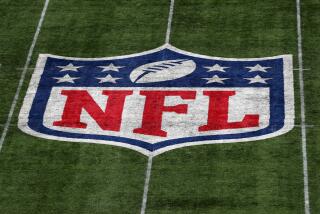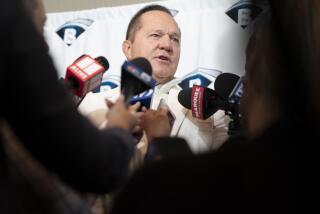NFL Searches for the Magic Number : Free agency: After five-year struggle, owners may be close to granting players their wish.
This is the fifth year of a bitter conflict matching the NFL’s club owners against the players. And you, perhaps, can now help them out.
Take a number between 1 and 7.
If it sounds reasonable to both groups, they could soon agree to end their disagreement.
Although numerous issues remain in a dispute that ranks among the nation’s longest-lasting contemporary labor quarrels, one question is clearly the most divisive: How many years must a pro football player serve with the team that chooses him before he is free to sign with a team that he chooses?
“If we said they’d all be free agents after two or three years, it would likely be agreeable to the players’ association,” the league’s new labor vice president, Harold Henderson, said. “As for the owners, they’d like (six or seven years). It’s a (controversy) that’s got to be resolved.”
In the week that is bringing another training-camp summer to pro football, the league hopesto resolve it soon, getting a start today during a special one-day owners’ meeting inDallas.
No final decisions will be made there on the number of years needed to earn free agency or anything else, Henderson said. But the labor war is the only subject on the agenda.
And what’s different about the NFL this time, as it confronts its knottiest problem once more, is a general acceptance, at last, that a policy of eventual freedom for all active players is inevitable, if not really advisable.
After 70 years, most owners have finally embraced the free-agent concept, the issue that split the players and the clubs into hostile camps in the mid-1980s, leading to the 1987 strike and an era of labor turbulence.
Their last collective bargaining agreement, signed in 1982, expired in ’87.
“There’s a new mood in the league this summer,” said Art Modell, president of the Cleveland Browns. “The (player-owner) battle has gone on long enough.”
Commissioner Paul Tagliabue, who has been leading the way, said: “(We’re) focusing on forms of unrestricted free agency.”
The NFL has come full circle, from flatly opposing free agents to discussing the years of experience necessary to qualify.
John Shaw, the Rams’ vice president, asked to pick a number between 1 and 7, said: “I have no views of my own, but if an agreement could be reached on free agency, it would be good for everyone.”
Said Gene Upshaw, the players’ executive director and author of their many recent successes: “I don’t see the owners coming up with the right number (today), but if they want to settle, they know the way. They know where the players are.”
Some of the league’s 28 clubs will, of course, vote against free agents until the end. But if supported by a 21-owner majority, the resolution will pass someday, offering freedom to all veterans after two years in the league, or three, four, five or six.
And as viewed from the league office, someday isn’t far off.
“I wouldn’t be embarking on this mission if I didn’t think we could sell an acceptable (version of) free agency to at least 21 owners,” said Henderson, the Harvard-trained lawyer and former Amtrak executive who became the NFL’s first executive vice president for labor relations when appointed by Tagliabue this year.
“We’re still formulating a plan,” Henderson said after 60 days in office. “We won’t put any proposal before (the owners) this week. What we want is to hear from them--what they can live with in the way of (free-agency) terms, salary caps, revenue sharing and the rest.
“(Sometime thereafter) we’ll put together a package that I think will be attractive to at least 21 of the clubs.”
Reminded that for many years a minority cadre of eight or nine owners has blocked all free-agency compromises, Henderson said: “I’ve often read that (NFL) owners never change, that they’re entrenched, recalcitrant--but after talking with many of them this year, I’m confident that they’re changing perspective. These are successful people who are flexible enough to meet the times.”
When and if the Henderson proposal gets NFL approval, he won’t be able to put it directly to the officers and members of the NFL Players Assn., leaders of the organization said. The NFLPA has disbanded as a union, renouncing its former role in labor negotiations.
But the NFLPA will hear about it.
“The only persons with the (legal power) to represent the players in negotiations with the owners today are our counsel in the (Freeman) McNeil antitrust (suit),” NFLPA Chief Counsel Richard Berthelsen said, referring to the landmark case destined to decide pro football free agency in a Minneapolis courtroom in February.
“The owners are wrong when they say there are no lines of communication to the players. As Upshaw says, ‘See my lawyer.’ The (NFLPA) role isn’t to bargain with the owners but to pay for the players’ litigation.”
And those who pay have a vested interest in the result.
The attorneys hired by the NFLPA for McNeil are Jeff Kessler and Joe Quinn of a New York firm, Weil, Gotshal and Manges, and at work this summer they won two rounds from the NFL, one on appeal to the U.S. 8th Circuit Court of Appeals.
Indeed, it is the NFLPA’s winning streak since March--five court cases, five NFL reverses--that has apparently inspired the league’s club owners to contemplate free agency and seek a settlement with the players.
Said Newport Beach sports lawyer Leigh Steinberg: “The tide turned in favor of the players in those (five cases). I think it’s obvious that the owners would be prudent to propose a generous collective bargaining agreement soon. Time is against them. The courts have upheld (NFLPA) decertification, and the draft is about to expire.”
One proposal that Henderson and other NFL leaders are considering would provide for:
--A player payroll cap of, say, $30 million a club.
--Minimum and maximum financial guarantees for each club.
--An income-sharing arrangement that would funnel, say, half of total NFL revenues to the players each season.
--A wage scale for NFL rookies and second-year pros.
--Free agency for veterans after two to six years. Pick a number.
From the commissioner’s office, Tagliabue said: “The salary cap is the key: A percentage of the gross (for the players) at one end and a salary cap at the other, (plus) a form of unrestricted free agency.”
The NFLPA objects to, among other things, the wage scale.
“When you have a (payroll) cap, there’s no economic justification for an entry-level wage scale,” said Doug Allen, the NFLPA’s assistant executive director. “The cap takes care of it, don’t you see? Just pay the guys anything you want up to the limit of the cap.”
But according to some NFL executives at the club level, a two-year wage scale would be in the best interests of the NFLPA’s veteran members if combined with an extension of the draft and a payroll-cap minimum.
The worst thing for veterans, they said, would be unrestricted rookie free agency combined with a payroll cap. That would put the clubs into competition with one another to pay ever larger salaries to unproved college players--leaving less money in the pot for established, productive NFL players.
The payroll-cap concept, as pioneered in the NBA, obliges each club to guarantee its players a minimum total salary sum each year.
And Henderson said that’s a major stumbling block to an NFL-wide agreement on labor issues.
“There’s a big difference in total revenues between our (rich) clubs and the (poor) clubs,” he said, placing the Rams and the New York Giants among the well-to-do by comparison with, for example, the Cincinnati Bengals and the Green Bay Packers. “The gap is over $12 million in some instances. So it’s hard to arrive at a (fair) minimum figure.”
Steinberg, however, said that most neutral observers are unimpressed by that argument.
“The owners’ largest source of income--TV money--is shared equally,” said the lawyer who represents many athletes. “The stadiums they play in are basically similar. And every team is free to build luxury boxes, not just the smart teams.
“The answer isn’t more revenue sharing. If there’s a $12-million gap between clubs, the answer is better management. After all, this is a free-enterprise country. The thing they call a problem in the NFL is exactly what capitalism encourages.”
Capitalism also encourages free agency, Upshaw said. In his Washington office, the head of the NFLPA said the next move is the NFL’s.
More to Read
Go beyond the scoreboard
Get the latest on L.A.'s teams in the daily Sports Report newsletter.
You may occasionally receive promotional content from the Los Angeles Times.










